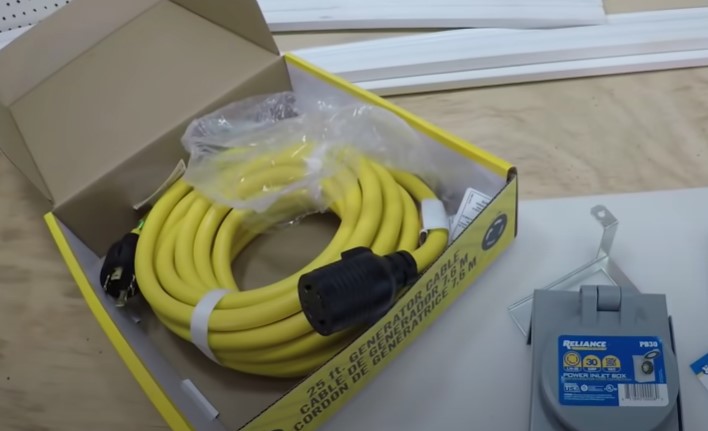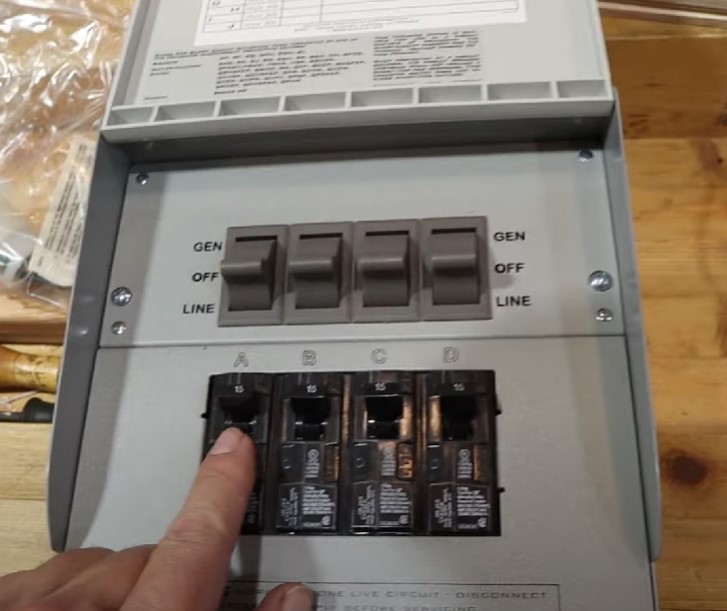Connecting a generator to a house without a transfer switch, first turn off the main power. Then, use an interlock kit to link the generator to the breaker box securely. Alternatively, connect the generator directly to appliances using extension cords or a power inlet box.
Testing the system and taking safety precautions is essential. Always consult a professional for advice and follow local and national electrical codes.
Don’t you want to spend extra money on a transfer switch and connect your generator to a house without a transfer switch? Well, in this article, we will cover everything about connecting the generator to a home without a transfer switch. Without further ado, let’s get started.
What are The Legal Ways to Connect Generators to a House?
Connecting a generator to a house involves careful adherence to local and national electrical codes to ensure safety and legality. Here are some of the common legal ways to connect a generator to a house:
Using a Transfer Switch
This is the most common and recommended way to connect a generator to a home. A transfer switch is a device that switches a load between two sources, making it possible to safely disconnect your home from the utility grid and switch over to the generator.
Portable Generator with Extension Cords
This is often used as a temporary solution during power outages. Extension cords run from the generator outside your home to the inside for specific appliances. Note that this method can only power a limited number of devices and does not provide comprehensive home backup power.
Generator with a Manual Interlock Kit
An interlock kit acts similarly to a transfer switch, allowing only one power source to feed the breaker box at any time. It’s a less expensive alternative to a transfer switch but still provides a legal and safe connection.
Power Inlet Box Installation
This is an ideal solution when you want to use a portable generator. The inlet box is installed on the exterior of the house and is hardwired to your circuit panel, allowing a safe generator connection.
In all scenarios, it’s essential to consult a licensed electrician to ensure the setup is done correctly, safely, and according to all applicable codes and standards. Also, local regulations may vary, so it’s crucial to verify with your local code enforcement agency or power company before modifying your home’s electrical system.

What is a Generator Transfer Switch?
A generator transfer switch is a device that allows for a safe and smooth transition between your home’s electrical supply from the utility company and a backup generator in case of a power outage. This switch isolates the electrical load, ensuring that the generator is not feeding power back into the utility lines, a dangerous situation known as backfeeding.
There are two main types of generator transfer switches: manual and automatic.
- Manual Transfer Switch: As the name suggests, this switch requires manual operation. When the power goes out, you’ll need to manually start your generator and then flip the transfer switch from ‘Line’ (utility power) to ‘Generator’ (backup power). Once the utility power is restored, you’ll need to manually flip the switch back and turn off the generator.
- Automatic Transfer Switch (ATS): This switch automatically detects when utility power is lost and initiates the start-up of the generator, then transfers the electrical load to the generator. When utility power is restored, it automatically switches the load back and shuts down the generator. An ATS is typically used with standby generator systems and is ideal for situations where immediate power restoration is crucial, such as hospitals, data centers, and homes with critical medical equipment.
Importance of Transfer Switch
Transfer switches play a critical role in a home generator system for various reasons:
- Safety: A transfer switch prevents backfeeding, a dangerous condition where electricity is pushed back into utility lines, potentially causing harm to utility workers or neighbors connected to the same transformer.
- Convenience: With an automatic transfer switch, the switch to generator power during a power outage is seamless and automated, so there’s no need to manually connect the generator.
- Load Management: Transfer switches can also manage electrical loads by prioritizing and reallocating power to different circuits, ensuring critical systems stay online during an outage.
- Legal Compliance: It’s usually a requirement by local and national electrical codes and utility companies to have a transfer switch for connecting a generator to a home’s electrical system.
- Protection of Equipment: By isolating generator power from utility power, a transfer switch protects your generator and electrical equipment from damage once power is restored.
- Versatility: A transfer switch allows the generator to supply power to hardwired appliances that cannot be powered by a generator through an extension cord.
- Ease of Use: The transfer switch eliminates the need for multiple heavy-duty extension cords from the generator to various household appliances.
How To Connect Generator To House Without Transfer Switch?
There are mainly 3 ways to connect a generator to the house without a transfer switch.
- Using Extension Cords to Connect a Generator to a House
- Using an Interlock Kit to Connect a Generator to a House
- Direct Connection to the Main Panel
Using Extension Cords to Connect a Generator to a House
The use of extension cords is one of the more straightforward methods to connect a generator to a house without using a transfer switch. This method is typically best suited for portable generators and only powers selected appliances.
1. Choosing the Right Extension Cord: It’s crucial to choose heavy-duty extension cords rated for outdoor use and the wattage of the connected appliances. The cables should also be long enough to keep the generator safe from the house (usually at least 20 feet) to avoid potential carbon monoxide hazards. Remember, under no circumstances should you use a damaged or frayed extension cord.
2. Connecting Appliances: The appliances you wish to power must be disconnected from the home’s electrical system before plugging them into the extension cords. This method only allows powering a limited number of devices – typically small appliances or devices that have their plug, such as lamps, refrigerators, fans, or space heaters.
3. Starting the Generator: Once you have the generator in a safe, outdoor location and the appliances connected, you can start the generator. Always refer to the generator’s manual for specific start-up procedures.
4. Managing Power: When using extension cords, it’s essential to manually manage power draw to prevent overloading the generator. You need to keep track of the total wattage being used by all the appliances connected to the generator to make sure it’s below the generator’s maximum output.
5. Safety Precautions: Never run cords under carpets or rugs, as this can create a fire hazard. Try to avoid making trip hazards with the cords. Also, never use a generator in wet conditions unless it’s under an open, canopy-like structure and on dry ground.
While using extension cords is a feasible way to connect a generator to your house without a transfer switch, it’s a temporary solution. It’s not suitable for running larger appliances or the entire house and may not comply with local codes or regulations. In most cases, a transfer switch is the safer, more convenient option.

Using an Interlock Kit to Connect a Generator to a House
An interlock kit is a budget-friendly alternative to a transfer switch. It enables your main electrical supply and generator to connect to the electrical panel safely. An interlock kit ensures that the generator and the utility power can’t be turned on simultaneously, preventing backfeeding.
1. Selecting the Right Interlock Kit: Interlock kits are designed to fit specific models and brands of electrical panels. It’s crucial to select an interlock kit that matches your breaker box to ensure a secure fit and safe operation.
2. Installation of the Interlock Kit: Installation involves attaching the interlock to the front of the panel, wiring a new breaker for generator power into the panel, and routing that wire to an external inlet box. The generator will then connect to this inlet box. The installation process is quite complex and involves working with your home’s electrical system, so it’s recommended that this task be performed by a licensed electrician.
3. Operation: When the power goes out, you’ll start your generator, connect it to the inlet box, and then slide the interlock plate, allowing the generator breaker to be turned on while preventing the main breaker from being in the on position. This isolates your home from the grid and directs the generator power to the circuit panel.
4. Power Management: Unlike a transfer switch that may offer load management, with an interlock kit, you’ll need to manage which breakers in your panel you turn on manually based on the capacity of your generator.
5. Safety: While the interlock kit is a safer alternative to methods like direct connection, there’s still a risk of backfeeding if not used correctly. Therefore, it’s essential always to make sure that the main breaker is off when the generator is running.
6. Legalities: Ensure the interlock kit you select is UL-listed and approved for use by local codes in your area.
While interlock kits are a cost-effective alternative to transfer switches, they require manual operation and careful power management. Also, they may not be legal in all areas or might not be accepted by some insurance policies, so it’s crucial to check with your local regulations and insurance provider.
Direct Connection to the Main Panel
Directly connecting a generator to the main panel without a transfer switch is a method that is generally discouraged due to its significant safety risks. This method involves wiring the generator directly to a circuit breaker in your electrical panel.
However, it’s essential to note that this method is widely considered dangerous and often illegal, and it can result in severe injuries or damage.
1. Procedure: A direct connection involves connecting a power cord from the generator to a dedicated circuit breaker in your electrical panel. This process should only be performed by a licensed electrician because it involves working directly with your home’s electrical system.
2. Risks: The most significant risk associated with a direct connection is the potential for backfeeding. Backfeeding occurs when power is sent back through the power lines connected to your house. This can pose an electrocution hazard for utility workers or anyone near downed power lines.
Furthermore, once the power comes back on, your generator could be damaged due to a surge of electricity from the utility service. This method also makes it easy to overload your generator, potentially causing damage or a fire.
3. Legal Issues: In many places, direct connections are illegal and violate the National Electrical Code (NEC). They can also void your house insurance policy in case of fire or other damages.
For all these reasons, directly connecting a generator to the main panel without a transfer switch is strongly discouraged. Safer and more recommended methods include using a transfer switch or an interlock kit, which prevent backfeeding and comply with safety regulations.
Always consult a professional before attempting to connect a generator to your home’s electrical system.

Safety Measures for Connecting a Transfer Switch to a Generator
Connecting a transfer switch to a generator involves dealing with electricity, which can be dangerous if not handled correctly. Here are several safety measures to keep in mind when making this connection:
1. Use Approved Equipment: Always use a transfer switch that has been approved by local and national electrical codes. Not all transfer switches may be suitable for your specific generator or electrical system, so make sure to use one that matches your setup.
2. Professional Installation: Hire a licensed electrician to install the transfer switch. The process involves making alterations to your home’s electrical system, which can be dangerous if not done correctly.
3. Turn Off the Main Breaker: Before connecting the generator to the transfer switch, ensure the main breaker is turned off to prevent back feed, which can be dangerous for utility workers and can damage the generator.
4. Avoid Overloading: Be aware of the power rating of your generator. Only connect devices that are within the total wattage that your generator can handle, as it can lead to overheating or generator failure.
5. Regular Inspection and Maintenance: Make sure the transfer switch and generator are in good working condition before using them. Regular maintenance helps to ensure that your equipment functions safely and correctly when you need it.
6. Proper Ventilation: Always place the generator outdoors in a well-ventilated area and away from windows or doors. Generators produce carbon monoxide, a dangerous gas that can be lethal in confined spaces.
7. Grounding: Follow all instructions and local codes regarding the grounding of both the generator and the transfer switch.
8. Waterproofing: Never use a generator in wet conditions. Electrical equipment should be kept dry at all times to prevent shock or electrocution.
9. Follow Instructions: Always read and follow the manufacturer’s instructions for your generator and transfer switch. This will ensure you are using the equipment correctly and safely.
These safety measures will help to ensure that your generator provides power effectively and safely during a power outage.
Transfer Switch vs Interlock Kit – Which One is Better?
Choosing between a transfer switch and an interlock kit depends on your specific needs, budget, and local regulations. Here’s a comparison of the two to help you make an informed decision:
Transfer Switch
Pros:
- Safety: Transfer switches are designed to prevent backfeeding, which could endanger utility workers and potentially cause a fire.
- Easy Operation: Once installed, they are relatively simple to use. Automatic transfer switches don’t require any manual intervention at all.
- Load Management: Some transfer switches can manage loads, prioritizing specific circuits over others.
Cons:
- Cost: Transfer switches can be more expensive than interlock kits, both in terms of equipment cost and installation, especially if you opt for an automatic transfer switch.
- Compatibility: Not all transfer switches work with all types of generators or electrical panels. Careful selection is required to ensure compatibility.
Interlock Kit
Pros:
- Cost-effective: Interlock kits are typically less expensive than transfer switches, making them a more affordable alternative for connecting a generator to your home.
- Full Panel Usage: They allow for the use of any circuit in the panel up to the capacity of the generator.
Cons:
- Manual Operation: Using an interlock kit requires manual operation each time you use your generator. You’ll need to be at home to start your generator and engage the interlock.
- No Load Management: Unlike some transfer switches, interlock kits do not provide load management. This means you’ll need to manually manage which appliances are running to avoid overloading your generator.
- Regulatory Restrictions: Not all local codes and utility companies allow the use of interlock kits, so it’s essential to verify this before installation.
Final Thoughts
In conclusion, if you’re looking for a more affordable, yet flexible option, and you don’t mind managing loads and manually operating your generator, an interlock kit could be a good choice. On the other hand, if you want a more seamless and hands-off approach or if you have a standby generator, a transfer switch would be the better option. Always consult with an electrician or professional to determine the best fit for your specific needs and local regulations.
Related Post:
Recent Posts
Yes, synthetic oil can generally be used in generators. It offers superior lubrication, improved resistance to temperature variations, and longevity compared to conventional oil, which can enhance...
In today's digital age, our dependency on computers and other electronic devices is undeniable. But what happens when a power outage occurs? This is where generators come in. However, is it safe to...
